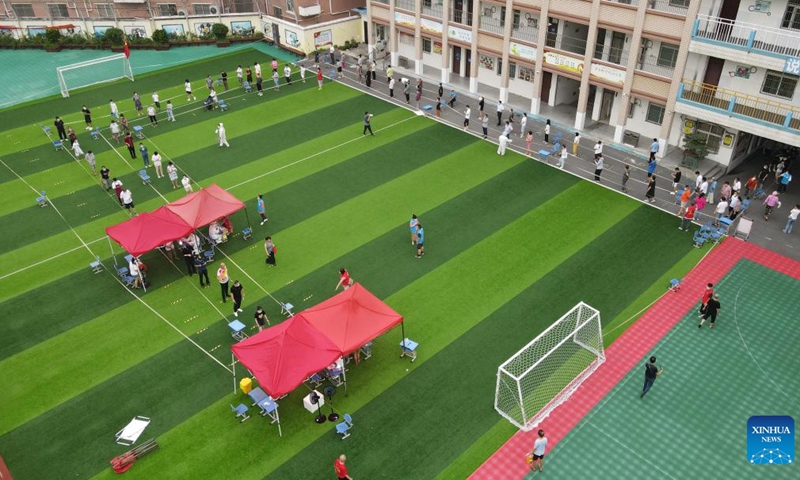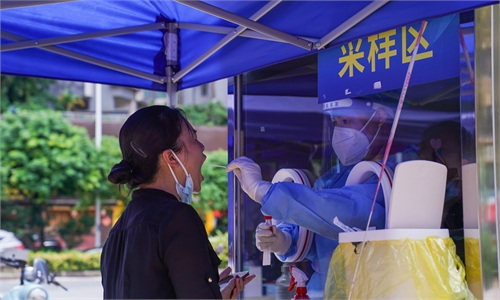Smaller Chinese cities battle Omicron resurgence with limited medical resources, financial pressure

Aerial photo taken on July 16, 2022 shows citizens standing in lines to take nucleic acid tests in Bengshan District of Bengbu City, east China's Anhui Province.Photo:Xinhua
The latest COVID-19 flare-ups have hit smaller cities in some provinces such as East China's Anhui Province and Northwest China's Gansu Province, showing a rising risk, as smaller regions face greater challenge due to limited medical resources and increasing financial pressure.
The country on Tuesday reported nearly 1,000 local COVID-19 positive cases. A total of 30 cases were detected in large cities like Beijing, Shanghai and Tianjin, while the rest of the cases were reported in other provincial-level regions including Anhui, Gansu, South China's Guangxi Zhuang Autonomous Region and Central China's Henan Province, according to the National Health Commission on Wednesday.
Zhumadian, a city in Henan with a population of more than 7 million people, on Tuesday reported 127 asymptomatic carriers.
With a population of over 935,000, Huaiyuan county in the city of Bengbu, Anhui has been under temporary sealed-off management since July 15 as the county detected 151 positive cases during a nucleic acid screening on July 14. The county has detected over 300 positive cases within only four days.
A local resident from the city of Bengbu told the Global Times that they were concerned when they first heard the news, but later they were relieved as the risk-free regions in the city are still open to free movement under epidemic prevention measures.
Huaiyuan authorities said on Tuesday that the county conducted five rounds of nucleic acid tests and no new cases were found at the community level in the fifth round test.
In response to the county's unscientific practice of using peracetic acid to spray roads, the authorities also said on Tuesday that they had made corrections and will follow the latest protocols on disinfection to further strengthen the training and supervision.
The county has a maximum testing capacity of 5,000 tubes per day, up to 100,000 times for nucleic acid testing, according to the authorities. Other cities in Anhui dispatched medical personnel and facilities to support the daily testing.
Based on a cost of 2.7 yuan per person, theoretically, the expenditure for each round of nucleic acid testing for all of the residents in the county is about 2.5 million yuan ($371,085).
Small cities are limited by resources, funds and other factors, and they are less capable of implementing epidemic prevention and control compared with large cities, Lu Hongzhou, head of the Third People's Hospital of Shenzhen, told the Global Times on Wednesday.
The lack of vigilance in COVID-19 in some local medical institutions may lead them to miss opportunities for "early detection, early reporting, early diagnosis and early quarantine," thus increasing the risk of the virus spreading, Lu said.
Moreover, the relatively weak awareness of COVID-19 prevention in small cities or counties and outdated health infrastructure in some areas can't meet the needs of infectious disease prevention and control, according to Lu.
Another county Sixian in the northern part of Anhui also has been facing a flare-up recently, with 1,698 positive cases detected from June 26 to July 9, according to Yicai.com on Wednesday.
Chinese Vice Premier Sun Chunlan said that the latest COVID-19 response protocols require precise prevention and control measures but not letting down one's guard. Sun made the remarks during her inspection in North China's Hebei Province from Monday to Tuesday on epidemic prevention and control.
Compared with the eighth edition, the ninth edition of the COVID-19 prevention and control protocol revised some contents in several aspects including quarantine management of risky groups, the criteria for medium- and high-risk regions' classification, and epidemic monitoring based on the characteristics of the Omicron variant.
Experts noted that the Omicron variant has become the dominant epidemic strain in the latest imported and local epidemics, as the incubation period of the variants is shortened, mostly from two to four days, and most of them can be detected within seven days.
For instance, according to the latest edition, the period of quarantine of COVID-19 close contacts and persons entering the country has been adjusted from "14 days of centralized quarantine plus seven days of home health monitoring" to "seven days of centralized quarantine plus three days of home health monitoring."
"The precise adjustment of the protocols does not mean the relaxation of the COVID-19 prevention and control policy, but it is more scientific and accurate, which aims to further release medical resources and reduce the impact on people's normal lives, achieving maximum control effect with minimum cost," Lu said.
Along with limited medical resources and increasing financial pressure, smaller cities or counties will face new challenges to slow down personnel flows amid the COVID-19 resurgence, said a Beijing-based expert on Wednesday.
The expert said that classified guidance for different-level cities or counties to curb the epidemic is needed. For the long term, the country might consider establishing a mechanism to support epidemic hard-hit regions with special and flexible resources, including professional medical personnel to help combat the epidemic.

